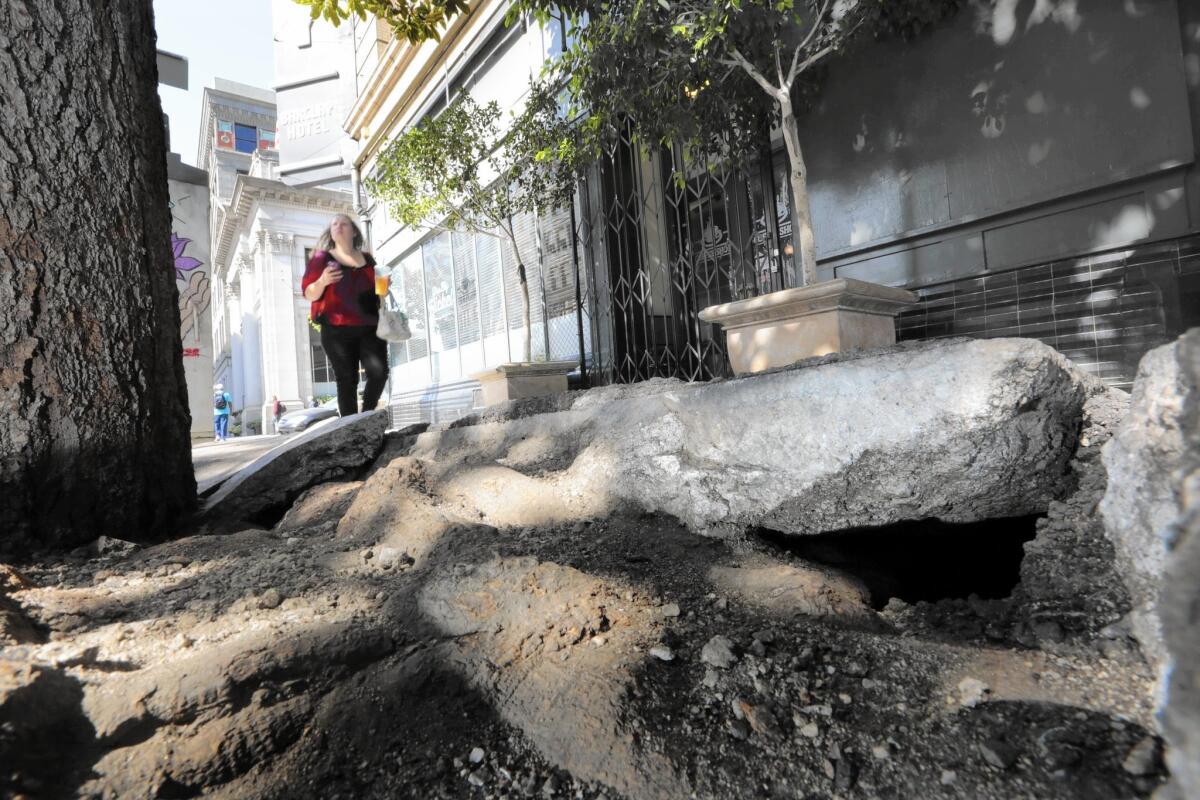L.A. to consider shifting responsibility for sidewalks to landowners

For decades, Los Angeles’ backlog of broken and lifted sidewalks has bedeviled pedestrians, cost the city millions annually in injury payouts and eluded a politically and financially palatable long-term solution.
On Tuesday, a top city budget official offered a sure-to-be-controversial approach to attacking the problem: gradually shifting responsibility for the liability and permanent maintenance of several thousand miles of city walkways to residential and commercial property owners.
The report by City Administrative Officer Miguel Santana offers the first road map for managing a $1.4-billion, 30-year sidewalk rebuilding program required under a pending settlement of a lawsuit filed by attorneys for the disabled.
Under the proposal, neighborhood walkways damaged by trees could be replaced at the city’s expense, after which responsibility for upkeep and liability for injuries would shift to the owners of adjoining homes.
For commercial properties, owners would be given a year to fix abutting sidewalks that city inspectors deem to be hazardous or inaccessible.
Santana’s plan, which will be publicly discussed in hearings beginning next week, would mark a departure from an unusual, 40-year-old policy that made the city responsible for repairing sidewalks damaged by the roots of city parkway trees.
State law has long placed the burden for such repairs on adjacent property owners. A majority of cities follow the state policy, according to the League of California Cities.
However, L.A. leaders opted to pay for tree-damaged walkway damage in the 1970s, when federal funding was available for the work. After the money ran out, L.A. voters declined to support tax increases to continue the repair work, and a massive backlog of uneven and temporarily patched walkways gradually developed.
The proposed policy is “intended to outlive that settlement term so that sidewalks are never in the disrepair that they are today,” Santana said in an interview. “The way we do that is sharing in the responsibility with the property owner.”
Early response to the plan was mixed, with some homeowners and elected officials saying the report is a starting point for a long-overdue discussion of how to address a chronic L.A. problem.
A spokeswoman said Mayor Eric Garcetti is looking forward to developing a comprehensive sidewalk repair plan, but declined to say if Garcetti supports Santana’s proposal.
Councilman Joe Buscaino, who heads the public works committee, said he wants to gather public input before taking a position on the plan.
Roozbeh Farahanipour, president of the West Los Angeles Chamber of Commerce, said Westside businesses aren’t likely to support Santana’s recommendations. The prevailing view, he said, is that cracked sidewalks — like broken streets — are a basic city responsibility.
“Because the businesses are paying taxes, they are assuming local government is taking care of their needs,” Farahanipour said.
Carlos Montes, president of the Boyle Heights Neighborhood Council, said requiring commercial land owners to pay for repairs could harm retailers in business districts such as East Cesar Chavez Avenue, which is lined with ficus trees that have buckled walkways.
“I’m worried property owners would pass the cost on to the small-business owners that rent,” Montes said. “Those sidewalks on Chavez are pretty bad.”
For residential areas, the report recommends a new “fix and release” program under which repairs would be made by the city and ongoing responsibility for the walkways then transferred to homeowners.
For sidewalks in good condition, a certificate of compliance would be issued to the property owner, who would then be held liable for any future repairs.
“It seems like a fair solution to the problem we’ve got,” said Hollywood Hills homeowner Dave Wilson, who has broken walkways in front of his property.
Montes disagreed, saying homeowners could be stuck with big bills down the road, particularly if the causes of the buckled walkways — such as tree roots or leaky water mains — are not corrected by the city.
City leaders have yet to decide how to handle trees with invasive roots, some of which are considered part of the picturesque character of older neighborhoods. The goal is to preserve as many trees as possible, officials say. But they acknowledge many will have to be removed and replaced with less-destructive varieties of trees.
Those sorts of issues will begin to be addressed publicly by city lawmakers Monday, when Santana presents his report at a joint hearing of the City Council’s budget and public works committees.
Councilmen Buscaino and Paul Krekorian are proposing a series of community hearings in the next month.
One key recommendation in Santana’s report is identifying for the first time the scope of the problem. Currently, city officials don’t know how many miles of sidewalks exist in the city and have no comprehensive inventory of their condition.
Previous estimates put the total sidewalk network at more than 10,000 miles, with more than 40% needing repair. There also is no centralized record-keeping on the location or condition of curb ramps.
“Without this information, it will be difficult to measure progress as the city implements its new sidewalk management strategy,” the report states.
Officials at the public works department should draw information from the city’s 311 telephone service request hotline, as well as a new citywide inspection program, according to Santana’s report.
More to Read
Sign up for Essential California
The most important California stories and recommendations in your inbox every morning.
You may occasionally receive promotional content from the Los Angeles Times.












